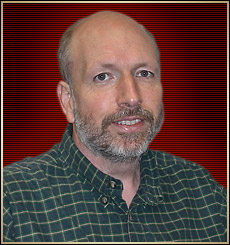Dr. Michael L. Simpson
The Singularity Is Near: When Humans Transcend Biology by Ray Kurzweil said
“An alternate method of designing nanobots is to learn from nature. Nanotechnologist Michael Simpson of Oak Ridge National Laboratory describes the possibility of exploiting bacteria ‘as ready-made machines’. Bacteria, which are natural nanobot-size objects, are able to move, swim, and pump liquids.”
Oak Ridge National Laboratory is the Department of Energy’s largest science and energy laboratory. Managed since April 2000 by a partnership of the University of Tennessee and Battelle, ORNL was established in 1943 as a part of the secret Manhattan Project to pioneer a method for producing and separating plutonium.
Dr. Michael L. Simpson is the founding Principal Investigator of the Molecular-Scale Engineering and Nanoscale Technologies (MENT) Research Group currently located at the Oak Ridge National Laboratory and the University of Tennessee. He is the Thrust Area Leader for the Nanofabrication Research Laboratory that will be located at Oak Ridge National Laboratory’s (ORNL) Center for Nanophase Material Science (one of five Department of Energy Nanoscience Research Centers) that began construction in April 2003. He received a Ph.D. from the University of Tennessee (UT) in Electrical Engineering in 1991 and is now a UT/ORNL Joint Faculty Member.
Mike’s academic appointments are in the Materials Science and Engineering and Electrical and Computer Engineering Departments at the rank of Professor, and he is a participating faculty member in the Center for Environmental Biotechnology and Tennessee Advanced Materials Laboratory Research Centers of Excellence. His research interests lie at the intersection of physical and life sciences with a particular focus on the analysis and modeling of information transport in biological systems and the development of molecular-scale interfaces between whole cells and nanostructured synthetic substrates. Mike has authored more than 90 papers and holds nineteen patents.
His papers include Shaping carbon nanostructures by controlling the synthesis process, Frequency domain analysis of noise in autoregulated gene circuits, Alignment mechanism of carbon nanofibers produced by plasma-enhanced chemical-vapor deposition, Whole-cell biocomputing, Fabrication of dissimilar metal electrodes with nanometer interelectrode distance for molecular electronic device characterization, Rewiring the cell: synthetic biology moves towards higher functional complexity, and Accelerating Gene Regulatory Network Modeling Using Grid-Based Simulation.
His patents include Bioluminescent bioreporter integrated circuit devices and methods for detecting estrogen, Methods for cell-based combinatorial logic, Controlled non-normal alignment of catalytically grown nanostructures in a large-scale synthesis process, Individually addressable cathodes with integrated focusing stack or detectors, Integrated CMOS spectrometers, Ion beam profile analyzer with noise compensation, Charge trapping correction in photon detector systems, and Simultaneous CT and SPECT tomography using CZT detectors.
Read his LinkedIn profile.
